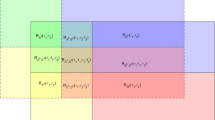Appendix I: Proof of Array Gain
In the optimized MISO antenna system, the transmit antenna weights can be found using (12). It follows that
$$ \left.{\mathbf{g}}_m\right|_{\rm opt}={\mathbf{G}}_{\rm opt}{\mathbf{e}}_m={\mathbf{H}}^{\dag}\left({\mathbf{H}}{\mathbf{H}}^{\dag}\right)^{-1}{\mathbf{e}}_m. $$
(25)
The square of the resultant channel response can be expressed as
$$ \begin{aligned} \beta_m^2&=\frac{ 1}{\|\left.{\mathbf{g}}_m\right|_{\rm opt}\|^2}\\ &=\frac{ 1}{ {\mathbf{e}}_m^{\dag}\left({\mathbf{H}}{\mathbf{H}}^{\dag}\right)^{-1}{\mathbf{e}}_m}\\ &=\frac{ {\tt det}\left[{\mathbf{H}}{\mathbf{H}}^{\dag}\right]}{ {\tt det}\left[{\mathbf{H}}^{(m)-}{\mathbf{H}}^{(m)-\dag}\right]} \end{aligned} $$
(26)
where H
(m)− agrees with the channel matrix H except that the m-th row corresponding to the channel from the base station to the m-th mobile station is missing, and \({\tt det}[\cdot]\) denotes the determinant of a matrix. Without loss of generality, we shall consider β
21
in the following for convenience.
Expanding \({\tt det}[{\mathbf{H}}{\mathbf{H}}^{\dag}]\) , we have
$$ {\tt det}[{\mathbf{H}}{\mathbf{H}}^{\dag}]=\sum_{m=1}^M(-1)^{m-1}{\mathbf{h}}_1{\mathbf{h}}_m^{\dag}\times{\tt det}\left[{\mathbf{H}}^{(1)-}{\mathbf{H}}^{(m)-\dag}\right] $$
(27)
where \({\mathbf{H}}=[{\mathbf{h}}_1,{\mathbf{h}}_2, \cdots ,\,{\mathbf{h}}_M]\) . As a consequence,
$$ \beta_1^2={\mathbf{h}}_1{\mathbf{h}}_1^{\dag}-\sum_{m=2}^M(-1)^m{\mathbf{h}}_1{\mathbf{h}}_m^{\dag}\times\frac{{\tt det}[{\mathbf{H}}^{(1)-}{\mathbf{H}}^{(m)-\dag}]}{{\tt det}[{\mathbf{H}}^{(1)-}{\mathbf{H}}^{(1)-\dag}]}. $$
(28)
In addition,
$$ \frac{{\tt det}[{\mathbf{H}}^{(1)-}{\mathbf{H}}^{(m)-\dag}]}{{\tt det}[{\mathbf{H}}^{(1)-}{\mathbf{H}}^{(1)-\dag}]}=\frac{ \sum_{i=2}^M(-1)^{i-1}{\mathbf{h}}_i{\mathbf{h}}_1^{\dag}{\tt det}[{\mathbf{M}}_i]}{\sum_{j=2}^M(-1)^{m+j-1}{\mathbf{h}}_j{\mathbf{h}}_m^{\dag}{\tt det}[{\mathbf{M}}_j]} $$
(29)
where M
i
is the sub-block matrix of \({\mathbf{H}}^{(1)-}{\mathbf{H}}^{(1)-\dag}\) after removing the i-th row and the m-th column. Then, each term under the summation of (28) can be expressed as
$$ (-1)^m{\mathbf{h}}_1{\mathbf{h}}_m^{\dag}\times\frac{{\tt det}[{\mathbf{H}}^{(1)-}{\mathbf{H}}^{(m)-\dag}]}{{\tt det}[{\mathbf{H}}^{(1)-}{\mathbf{H}}^{(1)-\dag}]}=\frac{\sum_{i=2}^M(-1)^{i-1}{\tt det}[{\mathbf{M}}_i]{\mathbf{h}}_i({\mathbf{h}}_1^{\dag}{\mathbf{h}}_1){\mathbf{h}}_m^{\dag}}{\sum_{j=2}^M(-1)^{j-1}{\tt det}[{\mathbf{M}}_j]{\mathbf{h}}_j{\mathbf{h}}_m^{\dag}}. $$
(30)
Using the fact that the channel elements are all independent and identically distributed and assuming that \(\hbox{E}[|h^{(m)}_{\ell,k}|^2]=1\,\forall m,k,\ell,\) the correlation matrix of the channel is \(\hbox{E}[{\mathbf{h}}_1^{\dag}{\mathbf{h}}_1]={\mathbf{I}}.\) Now, taking the average on both sides of (30), we obtain
$$ {\rm E}\left\{(-1)^m{\mathbf{h}}_1{\mathbf{h}}_m^{\dag}\times\frac{{\tt det}[{\mathbf{H}}^{(1)-}{\mathbf{H}}^{(m)-\dag}]}{{\tt det}[{\mathbf{H}}^{(1)-}{\mathbf{H}}^{(1)-\dag}]}\right\}={\rm E}\left\{\frac{\sum_{i=2}^M(-1)^{i-1}{\tt det}[{\mathbf{M}}_i]{\mathbf{h}}_i({\mathbf{h}}_1^{\dag}{\mathbf{h}}_1){\mathbf{h}}_m^{\dag}}{\sum_{j=2}^M(-1)^{j-1}{\tt det}[{\mathbf{M}}_j]{\mathbf{h}}_j{\mathbf{h}}_m^{\dag}}\right\} $$
(31)
$$ =\hbox{E}\left\{\frac{\sum_{i=2}^M(-1)^{i-1}{\tt det}[{\mathbf{M}}_i]{\mathbf{h}}_i{\rm E}({\mathbf{h}}_1^{\dag}{\mathbf{h}}_1){\mathbf{h}}_m^{\dag}}{\sum_{j=2}^M(-1)^{j-1}{\tt det}[{\mathbf{M}}_j]{\mathbf{h}}_j{\mathbf{h}}_m^{\dag}}\right\} $$
(32)
From (31) to (32), we have used the statistical independence between h
1 and \({\mathbf{h}}_m\,(m\ne 1)\) .
As a result,
$$ \begin{aligned} \Upomega_1=\hbox{E}[\beta_1^2]&={\rm E}[{\mathbf{h}}_1{\mathbf{h}}_1^{\dag}]-\sum_{m=2}^M{\rm E}\left\{(-1)^m{\mathbf{h}}_1{\mathbf{h}}_m^{\dag}\times\frac{{\tt det}[{\mathbf{H}}^{(1)-}{\mathbf{H}}^{(m)-\dag}]}{{\tt det}[{\mathbf{H}}^{(1)-}{\mathbf{H}}^{(1)-\dag}]}\right\}\\ &=n_T-M+1. \end{aligned} $$
(34)
For \(\Upomega_m\,(m\ne 1),\) the proof is similar.
Appendix II: Proof of Diversity Order
From (15),
$$ \Uppsi_1=\frac{\Upomega_1^2}{{\rm E}[(\beta_1^2-\Upomega_1)^2]}=\frac{\Upomega_1^2}{{\rm E}[\beta_1^4]-\Upomega_1^2}, $$
(35)
and β
41
can be expressed as
$$ \begin{aligned} \beta_1^4&=({\mathbf{h}}_1{\mathbf{h}}_1^{\dag})^2+2({\mathbf{h}}_1{\mathbf{h}}_1^{\dag})\sum_{m=2}^M(-1)^{m+1}{\mathbf{h}}_1{\mathbf{h}}_m^{\dag}\frac{{\tt det}[{\mathbf{H}}^{(1)-}{\mathbf{H}}^{(m)-\dag}]}{{\tt det}[{\mathbf{H}}^{(1)-}{\mathbf{H}}^{(1)-\dag}]}\\ &+\sum_{m=2}^M\left(\frac{{\mathbf{h}}_1{\mathbf{h}}_m^{\dag}{\tt det}[{\mathbf{H}}^{(1)-}{\mathbf{H}}^{(m)-\dag}]}{{\tt det}[{\mathbf{H}}^{(1)-}{\mathbf{H}}^{(1)-\dag}]}\right)^2\\ &+\sum_{m,n=2\atop m\ne n}^M\frac{(-1)^{m+n}{\mathbf{h}}_1{\mathbf{h}}_m^{\dag}{\tt det}[{\mathbf{H}}^{(1)-}{\mathbf{H}}^{(m)-\dag}]{\mathbf{h}}_1{\mathbf{h}}_n^{\dag}{\tt det}[{\mathbf{H}}^{(1)-}{\mathbf{H}}^{(n)-\dag}]}{\left({\tt det}[{\mathbf{H}}^{(1)-}{\mathbf{H}}^{(1)-\dag}]\right)^2}. \end{aligned} $$
(36)
The expectation of β
41
can be found by considering the expectation of each term on the right hand side (RHS). It can be shown (see Appendix III) that
$$ \hbox{E}\left\{({\mathbf{h}}_1{\mathbf{h}}_1^{\dag})^2\right\}=n_T^2+n_T; $$
(37)
$$ \hbox{E}\left\{\frac{({\mathbf{h}}_1{\mathbf{h}}_1^{\dag})({\mathbf{h}}_1{\mathbf{h}}_m^{\dag}){\tt det}[{\mathbf{H}}^{(1)-}{\mathbf{H}}^{(m)-\dag}]}{{\tt det}[{\mathbf{H}}^{(1)-}{\mathbf{H}}^{(1)-\dag}]}\right\}=(-1)^m(n_T+1); $$
(38)
$$ \hbox{E}\left\{\left(\frac{{\mathbf{h}}_1{\mathbf{h}}_m^{\dag}{\tt det}[{\mathbf{H}}^{(1)-}{\mathbf{H}}^{(m)-\dag}]}{{\tt det}[{\mathbf{H}}^{(1)-}{\mathbf{H}}^{(1)-\dag}]}\right)^2\right\}=2; $$
(39)
$$ \hbox{E}\left\{\frac{({\mathbf{h}}_1{\mathbf{h}}_m^{\dag}){\tt det}[{\mathbf{H}}^{(1)-}{\mathbf{H}}^{(m)-\dag}]({\mathbf{h}}_1{\mathbf{h}}_n^{\dag}){\tt det}[{\mathbf{H}}^{(1)-}{\mathbf{H}}^{(n)-}]}{\left({\tt det}[{\mathbf{H}}^{(1)-}{\mathbf{H}}^{(1)-\dag}]\right)^2}\right\}=(-1)^{m+n}. $$
(40)
It follows that
$$ \begin{aligned} {\rm E}[\beta_1^4]&=(n_T^2+n_T)-2(M-1)(n_T+1)+2(M-1)+(M-1)(M-2)\\ &=n_T^2+M^2+3n_T-3M-2Mn_T+2. \end{aligned} $$
(41)
Substituting (41) into (35) and using Ω1 in Theorem 3.2, we obtain
$$ \Uppsi_1=n_T-M+1 $$
(42)
and this completes the proof of Theorem 3.3.
Appendix III: Proofs of the Results (37)–(40)
Given i.i.d. zero-mean unity-variance complex Gaussian random variables, \(h^{(m)}_{\ell,k}\) , for \(m=1,\ldots,\,M, \ell=1\) (i.e., single-element mobile receivers), and k = 1,..., n
T
, it is easy to check that \(\hbox{E}[|h^{(m)}_{\ell,k}|^2]=1\) and \(\hbox{E}[|h^{(m)}_{\ell,k}|^4]=2.\) Based on these results, we prove (37)–(40).
3.1 Proof of (37)
Expanding \(\hbox{E}\{({\mathbf{h}}_1{\mathbf{h}}_1^{\dag})^2\}\) , we have
$$ \begin{aligned} \hbox{E}\left\{({\mathbf{h}}_1{\mathbf{h}}_1^{\dag})^2\right\}&={\rm E}\left\{\sum_{k=1}^{n_T}|h^{(1)}_{1,k}|^4+\sum_{k,\ell=1\atop k\ne\ell}^{n_T}|h^{(1)}_{1,k}|^2|h^{(1)}_{1,\ell}|^2\right\}\\ &=2n_T+n_T(n_T-1)=n_T^2+n_T. \end{aligned} $$
(43)
\(\square\)
3.2 Proof of (38)
Using (29), we can write
$$ \begin{aligned} &\quad{\rm E}\left\{\frac{({\mathbf{h}}_1{\mathbf{h}}_1^{\dag})({\mathbf{h}}_1{\mathbf{h}}_m^{\dag}){\tt det}[{\mathbf{H}}^{(1)-}{\mathbf{H}}^{(m)-\dag}]}{{\tt det}[{\mathbf{H}}^{(1)-}{\mathbf{H}}^{(1)-\dag}]}\right\}\\ &={\rm E}\left\{(-1)^m\frac{\left[\sum_{i=2}^M(-1)^{i-1}{\tt det}({\mathbf{M}}_i){\mathbf{h}}_i\right]{\mathbf{h}}_1^{\dag}({\mathbf{h}}_1{\mathbf{h}}_1^{\dag})({\mathbf{h}}_1{\mathbf{h}}_m^{\dag})}{\left[\sum_{j=2}^M(-1)^{j-1}{\tt det}({\mathbf{M}}_j){\mathbf{h}}_j\right]{\mathbf{h}}_m^{\dag}}\right\}\\ &={\rm E}\left\{(-1)^m\frac{\left[\sum_{i=2}^M(-1)^{i-1}{\tt det}({\mathbf{M}}_i){\mathbf{h}}_i\right]{\rm E}\left\{{\mathbf{h}}_1^{\dag}({\mathbf{h}}_1{\mathbf{h}}_1^{\dag}){\mathbf{h}}_1\right\}{\mathbf{h}}_m^{\dag}}{\left[\sum_{j=2}^M(-1)^{j-1}{\tt det}({\mathbf{M}}_j){\mathbf{h}}_j\right]{\mathbf{h}}_m^{\dag}}\right\}. \end{aligned} $$
(44)
Now, consider
$$ \hbox{E}\left\{{\mathbf{h}}_1^{\dag}({\mathbf{h}}_1{\mathbf{h}}_1^{\dag}){\mathbf{h}}_1\right\} =\hbox{E}\left\{\left(\sum_{k=1}^{n_T}|h^{(1)}_{1,k}|^2\right)\left[ \begin{array}{llll} |h^{(1)}_{1,1}|^2 & h^{(1)}_{1,2}h^{(1)*}_{1,1}&\cdots & h^{(1)}_{1,n_T}h^{(1)*}_{1,1}\\ h^{(1)}_{1,1}h^{(1)*}_{1,2}&|h^{(1)}_{2,2}|^2 & & \vdots\\ \vdots & & \ddots & \\ h^{(1)}_{1,1}h^{(1)*}_{1,n_T}&\cdots & & |h^{(1)}_{1,n_T}|^2 \end{array}\right]\right\}. $$
(45)
Apparently, the expectation of each entry is given by
$$ \begin{aligned} \hbox{E}\left\{h^{(1)*}_{1,i}h^{(1)}_{1,j}\sum_{k=1}^{n_T}| h^{(1)}_{1,k}|^2\right\}&=\left\{\begin{array}{ll} \hbox{E}[|h^{(1)}_{1,i}|^4]+{\rm E}[|h^{(1)}_{1,i}|^2] \sum_{j=1\atop j\ne i}^{n_T}{\rm E}[|h^{(1)}_{1,j}|^2] & i=j\\ 0 & i\ne j \end{array}\right.\\ &=\left\{\begin{array}{ll} n_T+1 & i=j\\ 0 & i\ne j. \end{array}\right. \end{aligned} $$
(46)
Consequently, we have
$$ \hbox{E}\left\{{\mathbf{h}}_1^{\dag}({\mathbf{h}}_1{\mathbf{h}}_1^{\dag}) {\mathbf{h}}_1\right\}=(n_T+1){\mathbf{I}} $$
(47)
so that, (44) yields
$$ \hbox{E}\left\{\frac{({\mathbf{h}}_1{\mathbf{h}}_1^{\dag})({\mathbf{h}}_1{\mathbf{h}}_m^{\dag}){\tt det}[{\mathbf{H}}^{(1)-}{\mathbf{H}}^{(m)-\dag}]}{{\tt det}[{\mathbf{H}}^{(1)-}{\mathbf{H}}^{(1)-\dag}]}\right\}=(-1)^m(n_T+1) $$
(48)
and this completes the proof. \(\square\)
3.3 Proof of (39)
Now, define an n
T
-dimensional row vector,
$$ {\mathbf{p}}=[p_1\,p_2\,\cdots]\triangleq\sum_{i=2}^M(-1)^{i-1}{\tt det}({\mathbf{M}}_i){\mathbf{h}}_i $$
(49)
which is independent of h
1. Using (29),
$$ \hbox{E}\left\{\left(\frac{{\mathbf{h}}_1{\mathbf{h}}_m^{\dag}{\tt det}[{\mathbf{H}}^{(1)-}{\mathbf{H}}^{(m)-\dag}]}{{\tt det}[{\mathbf{H}}^{(1)-}{\mathbf{H}}^{(1)-\dag}]}\right)^2\right\}={\rm E}\left\{\left(\frac{{\mathbf{ph}}_1^{\dag}{\mathbf{h}}_1{\mathbf{h}}_m^{\dag}}{{\mathbf{ph}}_m^{\dag}}\right)^2\right\}. $$
(50)
Expanding the RHS,
$$ \hbox{E}\left\{\left(\frac{{\mathbf{ph}}_1^{\dag}{\mathbf{h}}_1{\mathbf{h}}_m^{\dag}}{{\mathbf{ph}}_m^{\dag}}\right)^2\right\}= \hbox{E}\left\{\frac{\sum_{i,j,k,\ell=1}^{n_T}p_ih^{(m)*}_{1,j}p_kh^{(m)*}_{1,\ell} \hbox{E}\left\{h^{(1)*}_{1,i}h^{(1)}_{1,j}h^{(1)*}_{1,k}h^{(1)}_{1,\ell}\right\}}{ \sum_{i=1}^{n_T}\left[p_ih^{(m)*}_{1,i}\right]^2+\sum_{i,j=1\atop i\ne j}^{n_T}p_ih^{(m)*}_{1,i}p_jh^{(m)*}_{1,j}}\right\}. $$
(51)
The numerator of (51) can be simplified by partitioning \(i,j,k,\ell\) in the following:
$$ \Im_1=\{i=j=k=\ell\}, $$
(52)
$$ \Im_2=\{i=j\ne k=\ell\}, $$
(53)
$$ \Im_3=\{i=\ell\ne j=k\}, $$
(54)
and
$$ \begin{aligned} \Im_4&=\{i=k=\ell\ne j\}\cup\{j=k=\ell\ne i\}\cup\{i=j=k\ne\ell\}\\ &\cup\{i\ne j,k,\ell\}\cup\{j\ne i,k,\ell\}\cup\{k\ne i,j,\ell\}\cup\{\ell\ne i,j,k\}. \end{aligned} $$
(55)
In other words,
$$ \sum_{i,j,k,\ell=1}^{n_T}=\sum_{i,j,k,\ell\in\Im_1}+\sum_{i,j,k,\ell\in\Im_2}+ \sum_{i,j,k,\ell\in\Im_3}+\sum_{i,j,k,\ell\in\Im_4}. $$
(56)
To proceed, we obtain the expected value in the numerator of (51) for index values in the above four sets. It can be easily shown that
$$ \hbox{E}\left\{h^{(1)*}_{1,i}h^{(1)}_{1,j}h^{(1)*}_{1,k}h^{(1)}_{1,\ell}\right\}= \left\{\begin{array}{ll} \hbox{E}\left\{|h^{(1)}_{1,i}|^4\right\}=2 & i,j,k,\ell\in\Im_1,\\ \hbox{E}\left\{|h^{(1)}_{1,i}|^2\right\}{\rm E}\left\{|h^{(1)}_{1,k}|^2\right\}=1 & i,j,k,\ell\in\Im_2,\\ \hbox{E}\left\{|h^{(1)}_{1,i}|^2\right\}{\rm E}\left\{|h^{(1)}_{1,j}|^2\right\}=1 & i,j,k,\ell\in\Im_3,\\ 0 & i,j,k,\ell\in\Im_4. \end{array}\right. $$
(57)
As a result,
$$ \hbox{E}\left\{\left(\frac{{\mathbf{h}}_1{\mathbf{h}}_m^{\dag}{\tt det}[{\mathbf{H}}^{(1)-}{\mathbf{H}}^{(m)-\dag}]}{{\tt det}[{\mathbf{H}}^{(1)-}{\mathbf{H}}^{(1)-\dag}]}\right)^2\right\}= \hbox{E}\left\{\frac{\sum_{\Im_1}2\left[p_ih^{(m)*}_{1,i}\right]^2+\sum_{\Im_2,\Im_3} p_ih^{(m)*}_{1,i}p_jh^{(m)*}_{1,j}} {\sum_{i=1}^{n_T}\left[p_ih^{(m)*}_{1,i}\right]^2+\sum_{i,j=1\atop i\ne j}^{n_T}p_ih^{(m)*}_{1,i}p_jh^{(m)*}_{1,j}}\right\}=2. $$
(58)
3.4 Proof of (40)
Similar to (49), we define another n
T
-dimensional row vector as
$$ {\mathbf{q}}=[q_1\,q_2\,\cdots]\triangleq\sum_{i=2}^M(-1)^{i-1}{\tt det}({\mathbf{N}}_i){\mathbf{h}}_i $$
(59)
where N
i
is the sub-block matrix of \({\mathbf{H}}^{(1)-}{\mathbf{H}}^{(1)-\dag}\) after removing the i-th row and n-th column. As can be noted, q is also independent of h
1. Then, we can write
$$ \hbox{E}\left\{\frac{({\mathbf{h}}_1{\mathbf{h}}_m^{\dag}){\tt det}[{\mathbf{H}}^{(1)-}{\mathbf{H}}^{(m)-\dag}]({\mathbf{h}}_1{\mathbf{h}}_n^{\dag}){\tt det}[{\mathbf{H}}^{(1)-}{\mathbf{H}}^{(n)-}]}{\left({\tt det}[{\mathbf{H}}^{(1)-}{\mathbf{H}}^{(1)-\dag}]\right)^2}\right\}=(-1)^{m+n}{\rm E}\left\{\frac{({\mathbf{ph}}_1^{\dag}{\mathbf{h}}_1{\mathbf{h}}_m^{\dag})({\mathbf{qh}}_1^{\dag}{\mathbf{h}}_1{\mathbf{h}}_n^{\dag})}{({\mathbf{ph}}_m^{\dag})({\mathbf{qh}}_n^{\dag})}\right\}. $$
(60)
The RHS is further expanded as
$$ (-1)^{m+n}\hbox{E}\left\{\frac{({\mathbf{ph}}_1^{\dag}{\mathbf{h}}_1{\mathbf{h}}_m^{\dag})({\mathbf{qh}}_1^{\dag}{\mathbf{h}}_1{\mathbf{h}}_n^{\dag})}{({\mathbf{ph}}_m^{\dag})({\mathbf{qh}}_n^{\dag})}\right\}=(-1)^{m+n} \hbox{E}\left\{\frac{\sum_{i,j,k,\ell=1}^{n_T}p_ih^{(m)*}_{1,j}q_kh^{(n)*}_{1,\ell} \hbox{E}\left\{h^{(1)*}_{1,i}h^{(1)}_{1,j} h^{(1)*}_{1,k}h^{(1)}_{1,\ell}\right\}}{\sum_{i=1}^{n_T}p_ih^{(m)*}_{1,i}q_ih^{(n)*}_{1,i}+ \sum_{i,j=1\atop i\ne j}^{n_T}p_ih^{(m)*}_{1,i}q_jh^{(n)*}_{1,j}}\right\}. $$
(61)
Using (57), we can rewrite the numerator of RHS in (61) as
$$ 2\sum\limits_{i=1}^{n_T}p_ih^{(m)*}_{1,i}q_ih^{(n)*}_{1,i}+\sum_{i,j=1\atop i\ne j}^{n_T}p_ih^{(m)*}_{1,i} q_jh^{(n)*}_{1,j}+\sum_{i,j=1\atop i\ne j}^{n_T}p_ih^{(m)*}_{1,j}q_jh^{(n)*}_{1,i}. $$
(62)
Therefore,
$$ \begin{aligned} &\quad(-1)^{m+n}{\rm E}\left\{\frac{({\mathbf{ph}}_1^{\dag}{\mathbf{h}}_1{\mathbf{h}}_m^{\dag})({\mathbf{qh}}_1^{\dag}{\mathbf{h}}_1{\mathbf{h}}_n^{\dag})}{({\mathbf{ph}}_m^{\dag})({\mathbf{qh}}_n^{\dag})}\right\}\\ &=(-1)^{m+n}\left[1+{\rm E}\left\{\frac{\sum_{i=1}^{n_T}p_ih^{(m)*}_{1,i}q_ih^{(n)*}_{1,i}+ \sum_{i,j=1\atop i\ne j}^{n_T}p_ih^{(m)*}_{1,j}q_jh^{(n)*}_{1,i}}{\sum_{i=1}^{n_T}p_ih^{(m)*}_{1,i}q_ih^{(n)*}_{1,i}+ \sum_{i,j=1\atop i\ne j}^{n_T}p_ih^{(m)*}_{1,i}q_jh^{(n)*}_{1,j}}\right\}\right]\\ &=(-1)^{m+n}\left[1+{\rm E}\left\{\frac{({\mathbf{ph}}_n^{\dag})({\mathbf{qh}}_m^{\dag})}{({\mathbf{ph}}_m^{\dag})({\mathbf{qh}}_n^{\dag})}\right\}\right]. \end{aligned} $$
(63)
Note that
$$ \begin{aligned} {\mathbf{ph}}_n^{\dag}&=\sum_{i=2}^M(-1)^{i-1}{\tt det}({\mathbf{M}}_i){\mathbf{h}}_i{\mathbf{h}}_n^{\dag}\\ &={\tt det}\left[\begin{array}{lllllll} {\mathbf{h}}_2{\mathbf{h}}_n^{\dag} & {\mathbf{h}}_2{\mathbf{h}}_2^{\dag} & {\mathbf{h}}_2{\mathbf{h}}_3^{\dag} & \cdots & {\mathbf{h}}_2{\mathbf{h}}_n^{\dag} & \cdots & {\mathbf{h}}_2{\mathbf{h}}_{n_T}^{\dag}\\ {\mathbf{h}}_3{\mathbf{h}}_n^{\dag} & {\mathbf{h}}_3{\mathbf{h}}_2^{\dag} & {\mathbf{h}}_3{\mathbf{h}}_3^{\dag} & \cdots & {\mathbf{h}}_3{\mathbf{h}}_n^{\dag} & \cdots & {\mathbf{h}}_3{\mathbf{h}}_{n_T}^{\dag}\\ \vdots & & \ddots & & \vdots & \cdots & \vdots\\ {\mathbf{h}}_{n_T}{\mathbf{h}}_n^{\dag} & {\mathbf{h}}_{n_T}{\mathbf{h}}_2^{\dag} & & \cdots & {\mathbf{h}}_{n_T}{\mathbf{h}}_n^{\dag} & & {\mathbf{h}}_{n_T}{\mathbf{h}}_{n_T}^{\dag} \end{array}\right] \end{aligned} $$
(64)
and because the first column is the same as the (n + 1)-th column, this is a singular matrix and the determinant is thus zero. Same is also true for \({\mathbf{qh}}_m^{\dag}\) . As a result, we conclude that
$$ \hbox{E}\left\{\frac{({\mathbf{h}}_1{\mathbf{h}}_m^{\dag}){\tt det}[{\mathbf{H}}^{(1)-}{\mathbf{H}}^{(m)-\dag}]({\mathbf{h}}_1{\mathbf{h}}_n^{\dag}){\tt det}[{\mathbf{H}}^{(1)-}{\mathbf{H}}^{(n)-}]}{\left({\tt det}[{\mathbf{H}}^{(1)-}{\mathbf{H}}^{(1)-\dag}]\right)^2}\right\}=(-1)^{m+n}. $$
(65)
□




